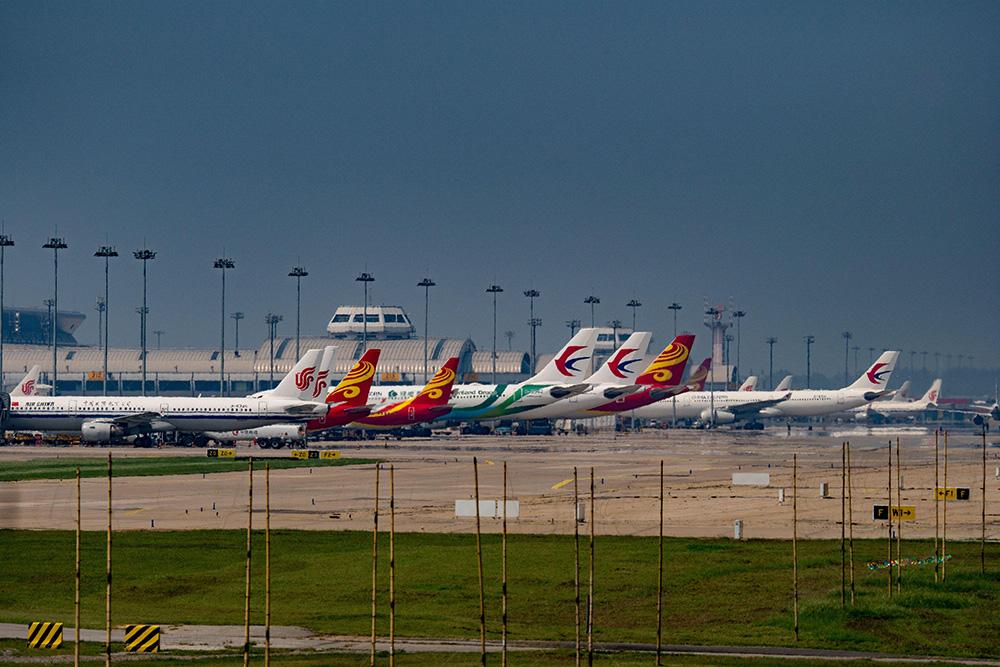Part Suppliers Face Challenges In China’s Rapidly-Recovering Aviation Market

Chinese air traffic, having gone through one of the deepest COVID-19 slumps, is now recovering fast. However, increased traffic is leading to increased demand for parts, and airlines are struggling to keep up. Supporting China's rapid recovery may require Chinese regulators to flex their rules on used parts—or U.S. companies may need to try harder to conform to existing rules.
U.S. civilian aircraft exports to China were nearly $2.9 billion in the first five months of 2023, up 39% in real terms from the same period of 2022, but still just half of the same exports in January through May of 2019.
In the first four months of 2023, total tonne-kilometers—domestics and international, passenger and freight—were up 65% from the same period of 2024, according to the Civil Aviation Administration of China (CAAC). As early as March 2023, China had exceeded pre-pandemic levels of domestic and international flights, notes Jerome Kan, director of business development at STS Component Solutions.
Fast recovery means a strong appetite for parts. “We see it every day with the rise in parts requests coming out of that region,” Kan says. STS has been seeing a steady rise in demand from Asia-Pacific this year, compared with 2022. “There has been a 25% increase in bookings year to date.”
But that booming demand is raising new challenges for suppliers like STS, the airlines it supplies and the CAAC itself.
Kan says part needs are equally intense for both Boeing and Airbus aircraft. Among part types in greatest demand, he cites pitot probes, oxygen face masks and passenger masks, lavatory equipment, oxygen bottles and batteries.
Chinese carriers are facing challenges in securing these and other new parts, and STS sees these airlines turning to more used parts. These used parts are critical to the recovery as a means of both shortening lead times and reducing costs. Kan says these advantages have prompted the CAAC to at least consider recognition of FAA certification for used parts. Historically, airlines and MROs have been allowed to use only CAAC-certified parts on Chinese-registered aircraft.
Used parts have always been a sensitive topic for the CAAC, given their conservative and safety-first approach, notes Joshua Ng, a director at Alton Aviation Consultancy. “Traceability has always been the guiding factor for used serviceable material usage in China, and that is a key reason that the circulation of used parts in China predominantly comes from Chinese airlines only,” Ng adds. “Having the provenance of the used parts, regardless of the domicile of the airline, would likely still be critical from a CAAC perspective, in light of the supply chain challenges.”
Ng says the question is not so much whether used parts are repaired by an FAA-certified repair station. For today, many OEMs and large MROs outside of China can release multiple certifications, such as FAA, European Union Aviation Safety Agency (EASA) and CAAC certifications. And, theoretically, the CAAC-certified parts could be installed on Chinese-registered aircraft.
However, Alton has observed that many part brokers certify parts with FAA/EASA dual-releases and seldom request the CAAC certification. Ng argues that better awareness by part suppliers of the huge used part market in China would help increase supply options and provide relief for the Chinese aviation market while offering another distribution channel for suppliers.
Other non-traditional part sources may also be looked at more favorably. Larger operators in China have been hesitant to install flight-critical parts manufacturer approval (PMA) products. However, Kan says STS’s recent conversations with Chinese airlines have indicated a more favorable attitude, as managers see operators globally embracing the reliability, improvements and cost benefits of PMAs. He notes that STS has been successful during and after the pandemic in working with multiple operators to gain approvals on PMA parts.
Airlines may be willing, but Alton’s Ng says lease agreements still largely forbid usage of PMA parts outside of the cabin. “That is a strong disincentive to PMA usage,” he says.
In any case, STS is trying hard to understand all the challenges operators face and tailor solutions that meet their needs. Kan ticks off some of the methods of supporting stressed Chinese airlines: increasing inventory levels to support demand, agreements to stock inventory for airlines and airline commitments to consume inventories under blanket agreements.
“Partnerships are the key to minimizing supply chain interruptions,” says Kan, noting that STS continues to keep open lines of communication with both airlines and suppliers. “Stocking the right parts is critical, but working with operators to also understand their pain points is a key to success,” he adds.





